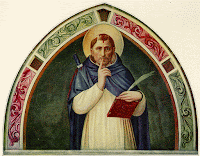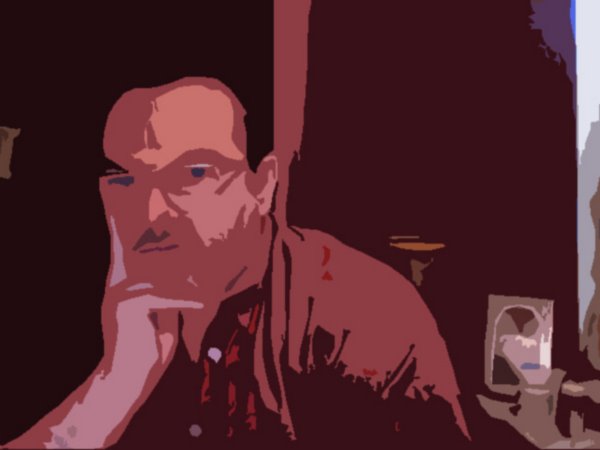.
Time to share sacred treasure found on another blog! Some days ago I read again the following homily by the Holy Father on Dom Mark Daniel Kirby's excellent blog Vultus Christi -- which is not so much a blog as it is a work of art guiding the faithful reader in the spiritual life adoring Christ our Eucharistic Saviour and Lord -- and found myself struck again by how much Pope Benedict XVI gives to the Church in his sermons and how little these treasures are disseminated throughout the Church! So I hope to do a little bit to advance the reading and remembrance of this memorable homily by reprinting it below together with the italicised remarks of Dom Mark Daniel Kirby, O.S.B. which at the very beginning give us context and background in brief.
[. . .] the feast of Pope Saint Peter Celestine, monk, Supreme Pontiff, and hermit. Last July 4th, in the context of the Year of Saint Celestine, proclaimed by the bishops of the Molise and Abruzzi regions of Italy, Pope Benedict XVI went to Aquila in pilgrimage to the saint. The Holy Father left his pallium on Saint Peter Celestine's tomb as a token of devotion to this remarkable saint who, after five months, resigned the papacy and retreated to his beloved solitude.
On the occasion of his visit to Aquila, Pope Benedict XVI Holy Mass and pronounced the following remarkable homily:
Hermit Elected Pope
Dear friends! My visit takes place on the occasion of the Jubilee Year proclaimed by the bishops of Abruzzo and Molise to celebrate the 800th anniversary of birth of St. Peter Celestine. Flying over your land I was able to contemplate the beauty of its landscape and, above all, admire some places closely linked to the life of this renowned figure: Mount Morrone, where Peter lived as a hermit for many years; the Hermitage of Sant'Onofrio, where in 1294 he received news of his election as Supreme Pontiff, which occurred at the conclave in Perugia; and the Abbey of Santo Spirito, whose main altar was consecrated by him after his coronation in the Basilica of Collemaggio in L'Aquila. In April of last year, after the earthquake that devastated this region, in this basilica I myself came to venerate the casket that contains his remains and leave the pallium that I received on the first day of my pontificate. More than 800 years have passed since the birth of St. Peter Celestine V, but he remains in history on account of the notable events of his pontificate and, above all, because of his holiness.

Ever Greater Luminosity of Holiness
Holiness, in fact, never loses its own power of attraction, it is not forgotten, it never goes out of fashion, indeed, with the passage of time, it shines with ever greater luminosity, expressing man's perennial longing for God. From the life of St. Peter Celestine, I would like to gather some teachings that are also valid for our days.
Silence
Peter Angelerio was a "seeker of God" from his youth, a man who was desirous to find the answers to the great questions of our existence: Who am I? Where do I come from? Why am I alive? For whom do I live? He went in search of truth and happiness, he went in search of God and, to hear his voice, decided to separate himself from the world and to live as a hermit. Silence thus became the element that characterized his daily life. And it is precisely in external silence, but above all in internal silence, that he succeeded in perceiving God's voice, a voice that was able to guide his life. Here a first aspect that is important for us: We live in a society in which it seems that every space, every moment must be "filled" with initiatives, activity, sound; often there is not even time to listen and dialogue. Dear brothers and sisters! Let us not be afraid to be silent outside and inside ourselves, so that we are able not only to perceive God's voice, but also the voice of the person next to us, the voices of others.
Divine Grace
But it is important to underscore a second element too: Peter Angelerio's discovery of God was not only the result of his effort but was made possible by the grace of God itself that came to him. What he had, what he was, did not come from him: it was granted to him, it was grace, and so it was also a responsibility before God and before others. Even if our life is very different from his, the same thing is also true for us: the entirety of what is essential in our existence was bestowed upon us without our intervention. The fact that I live does not depend on me; the fact that there were people who introduced me to life, that taught me what it means to live and be loved, who handed down the faith to me and opened my eyes to God: all of that is grace and not "done by me." We could have done nothing ourselves if it had not been given to us: God always anticipates us and in every individual life there is beauty and goodness that we can easily recognize as his grace, as a ray of the light of his goodness. Because of this we must be attentive, always keep our "interior eyes" open, the eyes of our heart. And if we learn how to know God in his infinite goodness, then we will be able to see, with wonder, in our lives -- as the saints did -- the signs of that God, who is always near to us, who is always good to us, who says: "Have faith in me!"
Beauty of Creation
In interior silence, in perceiving the Lord's presence, Peter del Morrone developed a lively experience of the beauty of creation, the work of God's hands: he knew its deepest meaning, he respected its signs and rhythms, he used it for what is essential to life. I know that this local Church, like the others of Abruzzo and Molise, are actively engaged in a campaign of sensitivity to and promotion of the common good and of safeguarding creation: I encourage you in this effort, exhorting everyone to feel responsible for their own future, and that of others, respecting and caring also for creation, fruit and sign of God's love.
The Wide Open Arms of the Crucified God
In today's second reading, taken from the Letter to the Galatians, we heard a beautiful expression of St. Paul, which is also a perfect spiritual portrait of St. Peter Celestine: "For me the only boast is in the cross of the Lord Jesus Christ, through which the world has been crucified to me and I to the world" (6:14). Truly the cross was the center of his life. It gave him the strength to face bitter penances and the most difficult times, from youth to his last hour: he was always aware that through it comes salvation. The cross also gave St. Peter Celestine a clear awareness of sin that was always accompanied by an awareness that was just as clear of God's mercy for his creature. Seeing the wide-open arms of his crucified God, he felt himself transported into the infinite sea of God's love. As a priest he experienced the beauty of being the administrator of this mercy, absolving penitents of sin, and, when he was elected to the See of the Apostle Peter, he wanted to grant a special indulgence called "The Pardon." I would like to exhort priests to be clear and credible witnesses of the good news of reconciliation with God, helping the man of today to recover the sense of sin and God's forgiveness, to experience that superabundant joy that the prophet Isaiah spoke to us about in the first reading (cf. Isaiah 66:10-14).
Evangelization Rooted in Prayer
Finally, a third element: St. Peter, although he lived as a hermit, was not "closed in on himself" but was filled with passion to bring the good news of the Gospel to his brothers. And the secret of his pastoral fruitfulness was precisely in "abiding" in the Lord, in prayer, as we were also reminded by today's Gospel passage: the first priority is always to pray to the Lord of the harvest (cf. Luke 10:2). And it is only after this invitation that Jesus outlines some of the essential duties of the disciples: the serene, clear and courageous proclamation of the Gospel message -- even in moments of persecution -- without ceding to the allurement of fashion nor to that of violence and imposition; detachment from worry about things -- money, clothing -- confiding in the providence of the Father; attention and care especially for the sick in body and spirit (cf. Luke 10:5-9). These were also the characteristics of the brief and trying pontificate of Celestine V and these are the characteristics of the missionary activity of the Church in every age.
Remain Solid in the Faith
Brothers and sisters! I am among you to confirm you in the faith. I would like to exhort you, firmly and with affection, to remain solid in that faith that you have received, which gives meaning to life and gives one strength to love. May the example and intercession of the Mother of God and of St. Peter Celestine accompany us on this journey. Amen!
+Laus Deo!


















